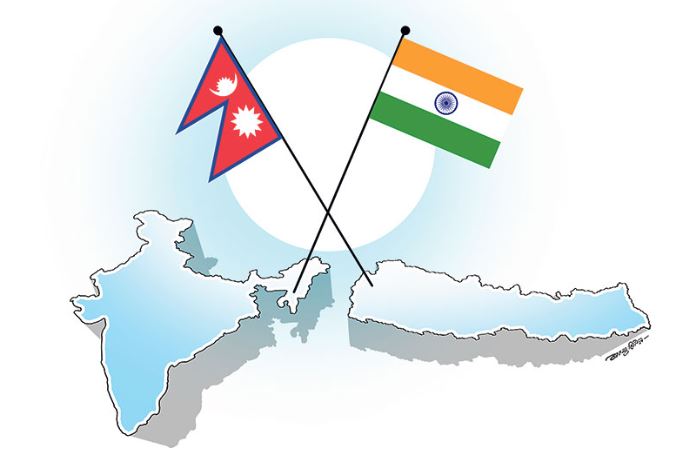India – Nepal relations: Irritants and the way forward

From Current Affairs Notes for UPSC » Editorials & In-depths » This topic
IAS EXPRESS Vs UPSC Prelims 2024: 85+ questions reflected

Context: The recent visit of Nepal’s Prime Minister to India
- This was his first bilateral visit abroad, in keeping with tradition.
Positive outcomes of the visit
Cross-border rail link: Among the highlights was the operationalisation of the 35-kilometre cross-border rail link from Jayanagar (Bihar) to Kurtha (Nepal).
Double circuit transmission line: The second project that was inaugurated was the 90 km long 132 kV double circuit transmission line connecting Tila (Solukhumbu) to Mirchaiya (Siraha) close to the Indian border.
Nepal’s induction into the International Solar Alliance: In addition, agreements providing technical cooperation in the railway sector, Nepal’s induction into the International Solar Alliance, and between Indian Oil Corporation and Nepal Oil Corporation on ensuring regular supplies of petroleum products were also signed.
The Mahakali Treaty:
- The Mahakali Treaty covers the Sarada and Tanakpur barrages as well as the 6,700 MW (approximately) Pancheshwar Multipurpose project.
- Both sides have agreed to push for the early finalisation of the detailed project report.
The joint vision statement on power sector cooperation:
- The joint vision statement on power sector cooperation recognises the opportunities for joint development of power generation projects together with cross border transmission linkages and coordination between the national grids.
- it can provide momentum.
Irritants between India and Nepal
The relationship took a nosedive in 2015:
- The relationship took a nosedive in 2015, with India first getting blamed for interfering in the Constitution drafting process and then for an “unofficial blockade” that generated widespread resentment against India.
Treaty of Peace and Friendship:
- As one of the oldest bonds, the 1950 Treaty of Peace and Friendship was originally sought by the Nepali authorities in 1949 to continue the special links they had with British India.
- It provides for an open border and for Nepali nationals to have the right to work in India.
- But today, it is viewed as a sign of an unequal relationship, and an Indian imposition.
- The idea of revising and updating it has found mentioned in Joint Statements since the mid-1990s.
Demonetisation of ₹1,000 and ₹500 currency notes:
- In November 2016, India withdrew ₹15.44 trillion of high value (₹1,000 and ₹500) currency notes.
- Many Nepali nationals who were legally entitled to hold ₹25,000 of Indian currency (given that the Nepali rupee is pegged to the Indian rupee) were left high and dry.
- The Nepal Rashtra Bank, which is the central bank, holds ₹7 crores and estimates of public holdings are ₹500 crores.
- After more than five years, it should certainly be possible to resolve this to mutual satisfaction.
Kalapani boundary issue:
- These boundaries had been fixed in 1816 by the British, and India inherited the areas over which the British had exercised territorial control in 1947.
- While 98% of the India-Nepal boundary was demarcated, two areas, Susta and Kalapani remained in limbo.
- In November 2019, India issued new maps following the division of the State of Jammu and Kashmir as Union Territories, Jammu and Kashmir and Ladakh.
- Though the new Indian map did not affect the India-Nepal boundary in any material way, a new map of Nepal was endorsed by the legislature through a constitutional amendment.
- While it did not alter the situation on the ground, it soured relations with India and added a new and emotive irritant.
China’s growing role:
- China has overtaken India as the largest source of foreign direct investment.
- Today, China is also engaged with airport expansion projects at Pokhara and Lumbini.
Need of the hour
- The growing Chinese presence in Nepal means that India cannot afford to let issues linger but reach out actively to find a resolution.
- Rather than compete with China, India needs to up its own game.
- The need today is to avoid rhetoric on territorial nationalism and lay the groundwork for quiet dialogue where both sides display sensitivity as they explore what is feasible.
- India needs to be a sensitive and generous partner for the “neighbourhood first” policy to take root.
Conclusion
- The political narrative has changed in both countries and these issues can no longer be swept under the carpet or subsumed by invoking a ‘special relationship’.
- Part of the success of the Nepal PM’s visit was that none of the differences was allowed to dominate the visit.
- Yet, to build upon the positive mood, it is necessary these issues be discussed, behind closed doors and at Track 2 and Track 1.5 channels.
Practice Question for Mains
- There needs to be quiet dialogue to resolve the many differences between India and Nepal, with New Delhi needing to be sensitive and generous. Discuss. (250 Words, 15 Marks)
If you like this post, please share your feedback in the comments section below so that we will upload more posts like this.

